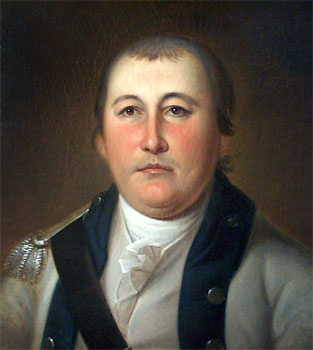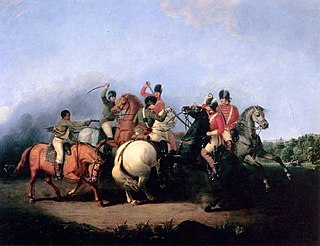
Charleston is the most populous city in the U.S. state of South Carolina,the county seat of Charleston County,and the principal city in the Charleston metropolitan area. The city lies just south of the geographical midpoint of South Carolina's coastline on Charleston Harbor,an inlet of the Atlantic Ocean formed by the confluence of the Ashley,Cooper,and Wando rivers. Charleston had a population of 150,227 at the 2020 census. The population of the Charleston metropolitan area,comprising Berkeley,Charleston,and Dorchester counties,was estimated to be 849,417 in 2023. It ranks as the third-most populous metropolitan statistical area in the state,and the 71st-most populous in the United States.

Edward Rutledge was an American Founding Father and politician who signed the Continental Association and was the youngest signatory of the Declaration of Independence. He later served as the 39th governor of South Carolina.

William Washington was a cavalry officer of the Virginia militia and Continental Army during the American Revolutionary War,who also served on General George Washington's staff during the naval war with France in 1798 and held a final rank of brigadier general. Primarily known as a commander of light dragoons,he led mounted troops in a number of notable battles in the Carolinas during the campaigns of 1780 and 1781. Following the conflict,this William Washington moved to South Carolina,where he married and served in the state legislature as well as led the Seventh Brigade of the South Carolina militia. Cavalry Commander William Washington of Stafford County and South Carolina has often been confused with his distant cousin William Augustine Washington,also a Revolutionary War patriot and planter,who served as a delegate representing Westmoreland County,Virginia.

Richard Hutson was a Founding Father of the United States and an American lawyer,judge,politician,and planter from Charleston,South Carolina. He was born in June 1747 to Rev. William Hutson and Mary Hutson. His family moved to Charleston in 1756 when his father was the pastor at the Circular Congregational Church. After having been educated in Charleston as a child,he attended Princeton.

Marion Square is greenspace in downtown Charleston,South Carolina,spanning six and one half acres. The square was established as a parade ground for the state arsenal under construction on the north side of the square. It is best known as the former Citadel Green because The Citadel occupied the arsenal from 1843 until 1922,when the Citadel moved to the city's west side. Marion Square was named in honor of Francis Marion.
The 1st North Carolina Regiment of the Continental Army was raised on September 1,1775,at Wilmington,North Carolina. In January 1776 the organization contained eight companies. Francis Nash was appointed colonel in April 1776. The regiment was present at the defense of Charleston in 1776. It transferred from the Southern Department to George Washington's main army in February 1777. At that time,Thomas Clark became colonel of the 1st Regiment. The regiment became part of General Francis Nash's North Carolina Brigade in July.
The 2nd North Carolina Regiment was an American infantry unit that was raised for the Continental Army during the American Revolutionary War. In 1776 the regiment helped defend Charleston,South Carolina. Ordered to join George Washington's main army in February 1777,the regiment subsequently fought at Brandywine and Germantown during the Philadelphia Campaign. After most other North Carolina regiments were sent home to recruit,the 1st and 2nd Regiments remained with the main army and fought at Monmouth in June 1778. The regiment was transferred to the Southern Department and was captured by the British army in May 1780 at the Siege of Charleston. Together with the 1st Regiment,the unit was rebuilt and fought capably at Eutaw Springs. The 2nd was furloughed in April 1783 and officially dissolved in November 1783.
The 3rd North Carolina Regiment was raised on 16 January 1776 at Wilmington,North Carolina for service with the Continental Army. In April,Jethro Sumner was appointed colonel. The regiment was present at the defense of Charleston in June 1776. The 3rd Regiment transferred from the Southern Department to George Washington's main army in February 1777. Assigned to Francis Nash's North Carolina Brigade in July 1777,it soon saw action at the battles of Brandywine and Germantown,and was present at White Marsh. Sumner went home ill in early 1778. Together with the 4th,5th,and 6th North Carolina Regiments,the 3rd Regiment was reduced to a cadre and sent home to recruit up to strength on 1 June 1778. The rebuilt regiment returned to the main army in late 1778,but it was reduced to a cadre again in April 1779 and sent back to its home state. Assigned to the North Carolina Brigade,the regiment fought at the Siege of Charleston where it was captured by the British Army on 12 May 1780. The regiment was officially disbanded on 15 November 1783.

The southern theater of the American Revolutionary War was the central theater of military operations in the second half of the American Revolutionary War,1778–1781. It encompassed engagements primarily in Virginia,Georgia,North Carolina,and South Carolina. Tactics consisted of both strategic battles and guerrilla warfare.
More than 1,500 African American officeholders served during the Reconstruction era (1865–1877) and in the years after Reconstruction before white supremacy,disenfranchisement,and the Democratic Party fully reasserted control in Southern states. Historian Canter Brown Jr. noted that in some states,such as Florida,the highest number of African Americans were elected or appointed to offices after the end of Reconstruction in 1877. The following is a partial list of notable African American officeholders from the end of the Civil War until before 1900. Dates listed are the year that a term states or the range of years served if multiple terms.

John Rutledge was an American Founding Father,politician,and jurist who served as one of the original associate justices of the Supreme Court and the second chief justice of the United States. Additionally,he served as the first president of South Carolina and later as its first governor after the Declaration of Independence was signed.

John Mathews was a Founding Father of the United States and lawyer from Charleston,South Carolina. He was a delegate to the Continental Congress from 1778 to 1781 where he endorsed the Articles of Confederation on behalf of South Carolina. On his return,he was elected the 33rd governor of South Carolina,serving a single term in 1782 and 1783.

The history of Charleston,South Carolina, is one of the longest and most diverse of any community in the United States,spanning hundreds of years of physical settlement beginning in 1670. Charleston was one of leading cities in the South from the colonial era to the Civil War in the 1860s. The city grew wealthy through the export of rice and,later,sea island cotton and it was the base for many wealthy merchants and landowners. Charleston was the capital of American slavery.
Edward North may refer to:
The following is a timeline of the history of Charleston,South Carolina,USA.
The Edenton District Brigade was an administrative division of the North Carolina militia during the American Revolutionary War (1776–1783). This unit was established by the North Carolina Provincial Congress on May 4,1776,and disbanded at the end of the war.
The New Bern District Brigade was an administrative division of the North Carolina militia during the American Revolutionary War (1776–1783). This unit was established by the North Carolina Provincial Congress on May 4,1776,and disbanded at the end of the war.
The Dobbs County Regiment was a unit of the North Carolina militia that served during the American Revolution. The regiment was one of thirty-five existing county militias that were authorized by the North Carolina Provincial Congress to be organized on September 9,1775. All officers were appointed with commissions from the Provincial Congress. On May 4,1776,the regiment was placed under the command of the New Bern District Brigade commanded by Brigadier General Richard Caswell. The regiment was active until the end of the Revolutionary War in 1783 and was engaged in twelve known battles and skirmishes in North Carolina,South Carolina and Georgia.









